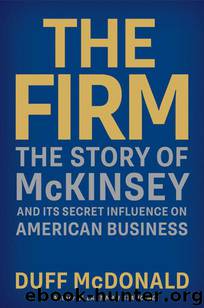The Firm: The Story of McKinsey and Its Secret Influence on American Business by McDonald Duff

Author:McDonald, Duff [McDonald, Duff]
Language: eng
Format: epub, azw3, mobi
Publisher: Simon & Schuster
Published: 2013-09-09T16:00:00+00:00
Not for Less Than $1 Million
By the end of the 1980s, McKinsey’s struggles at the end of the Marvin Bower era were long forgotten. The firm had moved into a higher gear, with revenues almost doubling, from $350 million in 1985 to $635 million in 1989. Over the next three years they nearly doubled again, hitting $1.2 billion in 1992. The Gluck-era focus on embracing one’s expertise was paying off in spades.
Remarkably, McKinsey was at that point demanding—and receiving—a substantial price premium over even its closest competitors. A “Competitive Assessment Review” from June 1989 showed just how powerful the brand had become. In a proposal for a large financial institution, Booz Allen Hamilton had offered to do the work in four to four and a half months, for $125,000 a month plus expenses, or about $675,000. McKinsey required more time—five to six months—and $175,000 per month plus expenses, a total of $1 million to $1.21 million. Despite its nearly double price tag, McKinsey won the assignment.
In 1982 McKinsey’s revenues per professional had been $180,000; by 1988 they were $320,000; and by 1992 they were $387,000. Booz Allen Hamilton pulled in just $200,000. And even if Andersen Consulting was by that point larger than McKinsey, its own revenues per professional were less than a third of McKinsey’s.16 It had always been Marvin Bower’s contention that McKinsey had no competition. As the years went on, the more right he became: If your direct competitors can bill at only 60 percent of your level, are they really even competing with you? On the other hand, deep down, McKinsey viewed some firms as threats. “Monitor, though only founded in 1983, is becoming a formidable competitor for the firm,” read one internal report. Booz, on the other hand, “[does] not pose a great threat to McKinsey’s overall preeminence in management consulting.”
Occasionally McKinsey consultants wondered whether they were pushing a little too far on the fee front. Some of their clients told them that they were. In a letter consultant Tom Steiner wrote to his colleagues in the New York office in 1990, he related a conversation with Chase Manhattan executive Mike Urkowitz. “[In a discussion] . . . several weeks ago [he] got up and closed his door and said that among his banking peers at conferences and other gatherings McKinsey’s prices were a subject of conversation,” Steiner wrote. “He said, ‘We all have the view that you won’t do anything for less than $1 million. You have a problem.’ ”
Still, as recently as the late 1980s, McKinsey’s fee arrangements with clients remained shockingly informal. The firm did not deign to explain to clients like Federated Department Stores how it arrived at a fee of $200,000 a month plus expenses—it was a take-it-or-leave-it proposition. In an interview with Fortune, Amsterdam office manager Mickey Huibregtsen said that the high fees were in the best interests of the company’s clients as well as McKinsey, because “they protect us from not being taken seriously by the client and that protects the client from having the wrong studies done.
Download
The Firm: The Story of McKinsey and Its Secret Influence on American Business by McDonald Duff.azw3
The Firm: The Story of McKinsey and Its Secret Influence on American Business by McDonald Duff.mobi
This site does not store any files on its server. We only index and link to content provided by other sites. Please contact the content providers to delete copyright contents if any and email us, we'll remove relevant links or contents immediately.
Pioneering Portfolio Management by David F. Swensen(6192)
Man-made Catastrophes and Risk Information Concealment by Dmitry Chernov & Didier Sornette(5895)
Zero to One by Peter Thiel(5652)
The Motivation Myth by Jeff Haden(5136)
The Miracle Morning by Hal Elrod(4533)
Elon Musk by Ashlee Vance(4003)
The Art of Persistence: Stop Quitting, Ignore Shiny Objects and Climb Your Way to Success by Michal Stawicki(3609)
Unlabel: Selling You Without Selling Out by Marc Ecko(3569)
Delivering Happiness by Tony Hsieh(3348)
Urban Outlaw by Magnus Walker(3319)
Purple Cow by Seth Godin(3120)
Mastering Bitcoin: Programming the Open Blockchain by Andreas M. Antonopoulos(2964)
The Marketing Plan Handbook: Develop Big-Picture Marketing Plans for Pennies on the Dollar by Robert W. Bly(2925)
The Power of Broke by Daymond John(2856)
The Content Trap by Bharat Anand(2847)
Applied Empathy by Michael Ventura(2825)
The Airbnb Story by Leigh Gallagher(2768)
Keep Going by Austin Kleon(2674)
Radical Candor by Kim Scott(2633)
